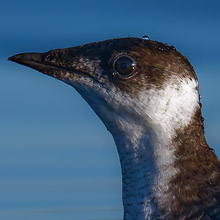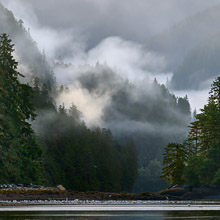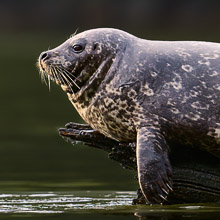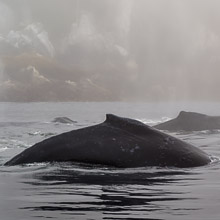Availability: Undetermined - Enquiries?
In the Field
Synchrony. Northern Coast, British Columbia, Canada. August 25, 2025.
The more time I watch (and photograph) Humpback Whales the more they amaze me. The spectacle of the fascinating behaviour of bubble-netting is widely known and probably the Humpback's most famous behavioural characteristic. But I find another - and more subtle - behaviour almost as fascinating, and it also requires a high degree of communication and coordination between individuals. The behaviour is best described simply as "synchrony", and it takes the form of coordinated and synchronous dives (and surfacing), synchronous blowing, synchronous foraging, and even synchronous breaching. We watched the whales in this image repeatedly foraging, surfacing, blowing, and fluking (diving) in near perfect synchrony while they swam in large circles and repeatedly through what appeared to be an almost stationary underwater cloud of baitfish. Beautiful synchrony!
I captured this image using a Nikon Z 9 body with a Tamron 35-150mm f2-2.8 zoom lens attached. I began shooting with this lens early in 2025 and found it to be an extremely valuable tool - it's extremely sharp, the focal range works great for me and I really like the fast 2-2.8 aperture. This lens was available first in the Sony mount and subsequently Tamron brought it out in the Z mount. Until recently this lens was almost in a category of its own with no other lenses offering the same focal length range and/or maximum aperture of f2. Sony's new FE 50-150mm f2 GM OSS is the closest thing to a competitor to the Tamron 35-150mm - it has a wider aperture from about 50mm through to 150mm but it is significantly larger (and much more expensive).
While the Tamron 35-150mm f2-2.8 replaced the Nikkor Z 24-120mm f4S in my kit on all of my photo tours in 2025, I am in NO WAY feeling negative about the Nikkor 24-120mm f4. Its positive features - excellent sharpness, highly useful focal range, and really small size and low weight - are STILL there! The Tamron 35-150mm offers a slightly "longer" focal range, a maximum aperture of 1-2 stops wider (depending on focal length) and sharpness at least equal to the Nikkor Z 24-120mm f4. But, the Tamron is much heavier and much larger. If I was forced to choose one or the other (which, fortunately, I'm not) I would probably go for the Tamron 35-150mm over the Nikkor 24-120 simply because I often need or want its larger aperture (for its better low light performance and its better ability to isolate subjects from their backgrounds).
Here's a larger version (4800 pixel) of five graceful giants:
• Synchrony: Download 4800 pixel image (JPEG: 2.2 MB)
ADDITIONAL NOTES:
1. These images - in all resolutions - are protected by copyright. I'm fine with personal uses of them (including use as desktop backgrounds or screensavers on your own computer), but unauthorized commercial use of the image is prohibited by law. Thanks in advance for respecting my copyright!
2. Like all photographs on this website, these images were captured following the strict ethical guidelines described in The Wildlife FIRST! Principles of Photographer Conduct. As such, no baiting or any form of attractant was used and, as always, we attempted to minimize our impact on the ongoing behaviour of the subjects. I strongly encourage all wildlife photographers to always put the welfare of their subjects above the value of their photographs.
3. This image was captured during my Khutzeymateen Summer Explorer Exploratory Photo Adventure in late August of 2025. Each year I offer photo tours into various locations on the amazing BC coast, including the Great Bear Rainforest and, every other year, into the Khutzeymateen Grizzly Sanctuary (to photograph grizzlies, of course!). Details about these trips can be found on the Photo Tours page of this website.
Behind the Camera
Synchrony. Northern Coast, British Columbia, Canada. August 25, 2025.
High Efficiency* Compressed RAW (NEF) format; ISO 125.
Nikon Z 9 paired with Tamron 35-150mm f2-2.8 Di III VXD zoom lens @ 68mm. Hand-held from power boat. VR on in Sport mode. Wide AF custom (13x3) area mode with subject detection on "Birds" mode.
11/1250s @ f4; no compensation from matrix-metered exposure setting.
At the Computer
Synchrony. Northern Coast, British Columbia, Canada. August 25, 2025.
Initial noise reduction and capture sharpening on the .nef (raw) file using the DeepPRIME XD2S algorithm of DXO PhotoLab 9.1 Elite (using the appropriate lens/camera optical module).
Subsequent adjustments to the adjusted linear DNG file (exported from PhotoLab) and conversion to 16-bit TIFF file (and JPEG files for web use) - including all global and selective adjustments - made using Capture One Pro (build 16.6.3). In the case of this image the only global adjustment made was to overall contrast (using a Levels adjustment). Selective local adjustments performed using Capture One Pro's layers and masking tools. In this case numerous small adjustments and minor tweaks were made on 4 separate layers, with the tweaks being associated with "exposure balancing" and contrast adjustments (such as adjustments to brightness, clarity, highlights, shadows, blacks, etc.).
Photoshop modifications included insertion of the watermark and/or text.
Conservation
Synchrony. Northern Coast, British Columbia, Canada. August 25, 2025.
Species Status in Canada*: This species is not designated as at risk.
Humpback Whales (Megaptera novaeagnliae) are active, acrobatic whales that can throw themselves completely clear of the water (a behaviour known as breaching) and will swim on their backs with both flippers in the air. Humpbacks are large (up to 14m - or 46 feet - in length and 40 tonnes in weight) and with huge flippers.
Humpbacks are found in tropical, temperate, and sub-polar waters around the world. They are found on both the east and west coasts of North America. The North Pacific population has been estimated at between 6,000 and 8,000 individuals, but only a few hundred of these are found in the waters off the coast of British Columbia.
While Humpbacks are recovering from the damage done to their populations by commercial fishing, the are still subject to a variety of threats from human activities, including becoming entangled in fishing nets, noise and chemical pollution and habitat destruction.
**as determined by COSEWIC: The Committee on the Status of Endangered Wildlife in Canada


























